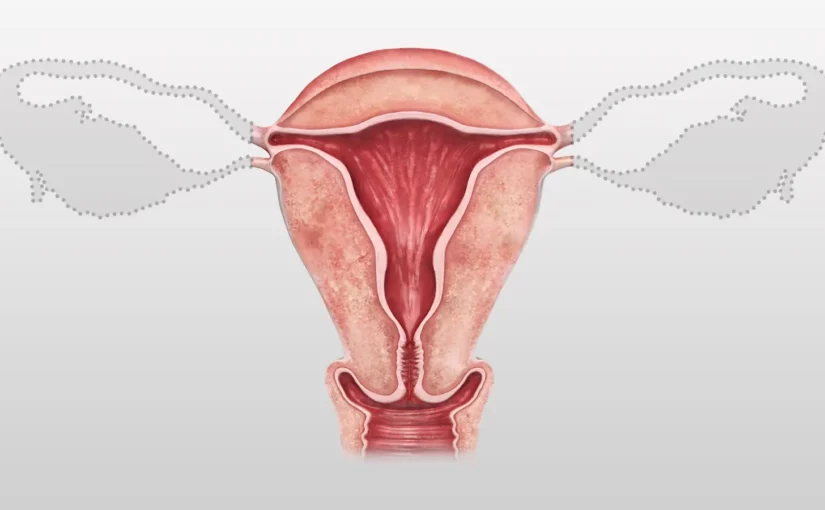by Charles Bankhead
— Women with BRCA variant and serous tubal intraepithelial carcinoma had a 34-fold greater risk
The presence of serous tubal intraepithelial carcinoma (STIC) at the time of risk-reducing salpingo-oophorectomy (RRSO) significantly increased the risk of peritoneal carcinomatosis (PC) in BRCA1/2 mutation carriers, a large meta-analysis showed.
The risk of PC increased from 10.5% at 5 years to 27.5% at 10 years, as compared with 0.3% and 0.9% for women without STIC. Women with STIC had a cumulative hazard ratio for PC of 33.9 versus women without STIC.
Although the data confirmed a suspected association between BRCA1/2, STIC, and PC, the conclusions were based on a small number of events, reported Miranda P. Steenbeek, MD, of Radboud University Medical Center in Nijmegen, the Netherlands, and co-authors in the Journal of Clinical Oncology.
“The most important direct clinical implication is the increased knowledge on PC risk after RRSO, which should be used to postoperatively inform patients when discussing the pathology reports,” the authors wrote. “This is important for both women with STIC, as for women without STIC since their risk for PC is lower than formerly communicated.”
Because STIC is identified more often by the sectioning and extensively examining the fimbriated end (SEE-FIM) protocol, the findings emphasize the importance of adhering to this protocol, they added.
The data are reassuring for BRCA1/2 carriers without STIC but more complicated for women who have STIC at RRSO, according to the authors of an accompanying editorial.
“Although they do appear to have an increased risk of peritoneal carcinomatosis, there is considerable uncertainty regarding optimal management of patients with a STIC,” wrote Kelly-Anne Phillips, MBBS, MD, of the Peter MacCallum Cancer Centre in Melbourne, and Michael L. Friedlander, MBChB, PhD, of the University of New South Wales in Sydney. “What is clear is that timely [RRSO] at the age recommended in guidelines is important, not only to reduce the potential risk for epithelial ovarian cancer but also to reduce the risk of STIC and potentially subsequent peritoneal carcinomatosis.”
“However, [the study] will generate complex conversations between clinicians and their patients, given the current high level of uncertainty about the best way to mitigate the risk of peritoneal carcinomatosis after a diagnosis of isolated STIC, and this should be a catalyst for further research,” they added.
Carriers of BRCA pathogenic variants have a lifetime risk of epithelial ovarian cancer ranging from 17% (BRCA2) to 44% (BRCA1). RRSO offers the most effective prevention, reducing the risk by as much as 96%, Steenbeek and co-authors noted. Despite the cancer-reducing benefits of RRSO, a risk of PC persists, reaching an estimated cumulative risk of 3.9% for BRCA1 carriers and 1.9% for BRCA2 carriers.
The origin of PC has remained unclear. Initially, PC was thought to arise from the pelvic peritoneum. However, subsequent evidence implicated STIC as a precursor of high-grade serous carcinoma. In one study, the prevalence of STIC in original RRSO tissue exceeded 60%, although the finding was limited by small numbers. Even so, the prevalence of STIC was higher than expected, suggesting an association between PC and STIC, Steenbeek and co-authors said.
In an effort to shed more light on the origin of PC and its relationship to STIC, the authors performed a systematic literature review to identify studies of women with BRCA pathogenic variants with and without STIC through September 2020. They identified 15 studies with individual patient data for 3,121 patients, of whom 115 had STIC at RRSO.
A meta-analysis showed that STIC in association with a BRCA pathogenic variant significantly increased the hazard for PC as compared with a BRCA variant without STIC (95% CI 15.6-73.9, P<0.001), and the magnitude of the difference increased over time. The risk of PC was significantly elevated for patients with STIC at 5 years (95% CI 6.2-17.2) and 10 years (95% CI 15.6-43.9) compared with those who had no STIC (95% CI 0.2-0.6 and 95% CI 0.6-1.4).
Though significantly different, the absolute numbers were small. Of the 115 women with STIC at RRSO, 15 (13%) developed PC during a median follow-up of 52.5 months compared with 12 of 3,006 (0.4%) women without STIC. The median time from RRSO to PC was 48.0 months for women with STIC and 50.8 months for women without STIC. No PC occurred during the first 18 months after RRSO.
This article was published by Med Page Today.


